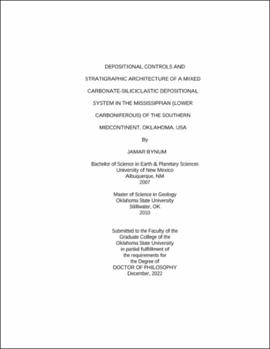| dc.contributor.advisor | Pashin, Jack | |
| dc.contributor.author | Bynum, Jamar | |
| dc.date.accessioned | 2023-07-05T20:56:54Z | |
| dc.date.available | 2023-07-05T20:56:54Z | |
| dc.date.issued | 2022-12 | |
| dc.identifier.uri | https://hdl.handle.net/11244/337888 | |
| dc.description.abstract | The Anadarko Basin of the North American Midcontinent has been explored by the hydrocarbon industry for decades, and recent efforts have created an opportunity to analyze robust modern geologic datasets for investigating the depositional controls and stratigraphic architecture of Mississippian (Lower Carboniferous) reservoirs in the region. Core-based facies analysis coupled with the integration of geophysical well logs and previous biostratigraphic studies are the fundamental building blocks for investigating the evolution of a carbonate depositional system to a mixed carbonate-siliciclastic system. Initial deposition in the region was characterized by marine transgression and followed by a period of stabilization, with aggradation of the carbonate system on the Burlington shelf and coeval deposition of biostromal sponge gardens and outer ramp facies in the study area. This event was followed by progradation of the carbonate system, establishing the Meramecian (Viséan) Boardman ramp margin in north-central Oklahoma, where thick successions of carbonate shoal and proximal storm deposits accumulated. The final depositional episode was characterized by an abrupt transition from carbonate to siliciclastic deposition, in which thick successions of Chesterian (Viséan-Serpukhovian) siliciclastics prograded from the Boardman ramp margin into the Anadarko Basin. As a result of this depositional evolution the reservoir architecture changes across the Anadarko Basin as progradational proximal carbonate facies transition to storm dominated ramp margin conditions, and finally to the more prolific unconventionally targeted siliciclastic siltstone and mudstone facies of the outer ramp. The vertical and lateral facies distributions were investigated further within the STACK play. Statistical analysis on facies logs indicates a highly layered rhythmic succession, where thickness frequency distributions and Markov chain analysis indicate the lithologic transitions were stochastically regulated with no apparent lithologic cyclicity. Overall, the Mississippian contains two progradational parasequence sets separated by a disconformity associated with the inception of the Ouachita Orogeny. While the onset of transition from a greenhouse to icehouse climatic regime was underway, far-field tectonic effects provided the predominant controls on deposition. | |
| dc.format | application/pdf | |
| dc.language | en_US | |
| dc.rights | Copyright is held by the author who has granted the Oklahoma State University Library the non-exclusive right to share this material in its institutional repository. Contact Digital Library Services at lib-dls@okstate.edu or 405-744-9161 for the permission policy on the use, reproduction or distribution of this material. | |
| dc.title | Depositional controls and stratigraphic architecture of a mixed carbonate-siliclastic depositional system in the Mississippian (Lower Carboniferous) of the Southern Midcontinent, Oklahoma, USA | |
| dc.contributor.committeeMember | Puckette, Jim | |
| dc.contributor.committeeMember | Grammer, Michael | |
| dc.contributor.committeeMember | Nygaard, Runar | |
| dc.contributor.committeeMember | Coffey, Bill | |
| osu.filename | bynum_okstate_0664d_17934.pdf | |
| osu.accesstype | Open Access | |
| dc.type.genre | Dissertation | |
| dc.type.material | Text | |
| thesis.degree.discipline | Geology | |
| thesis.degree.grantor | Oklahoma State University | |
